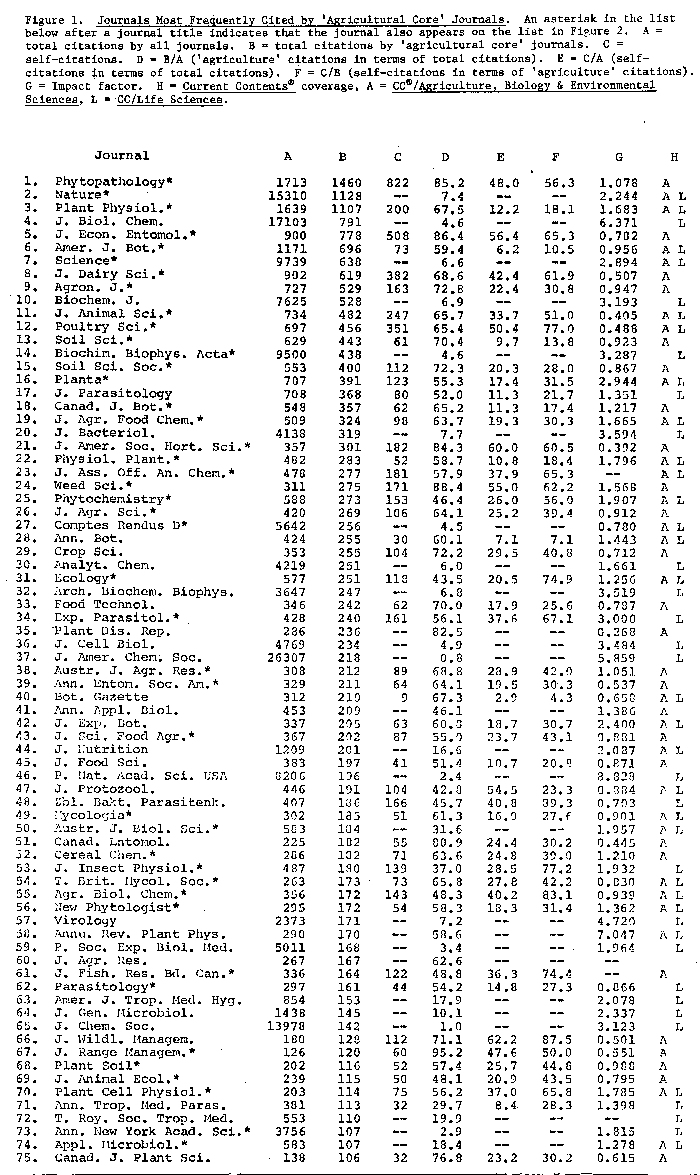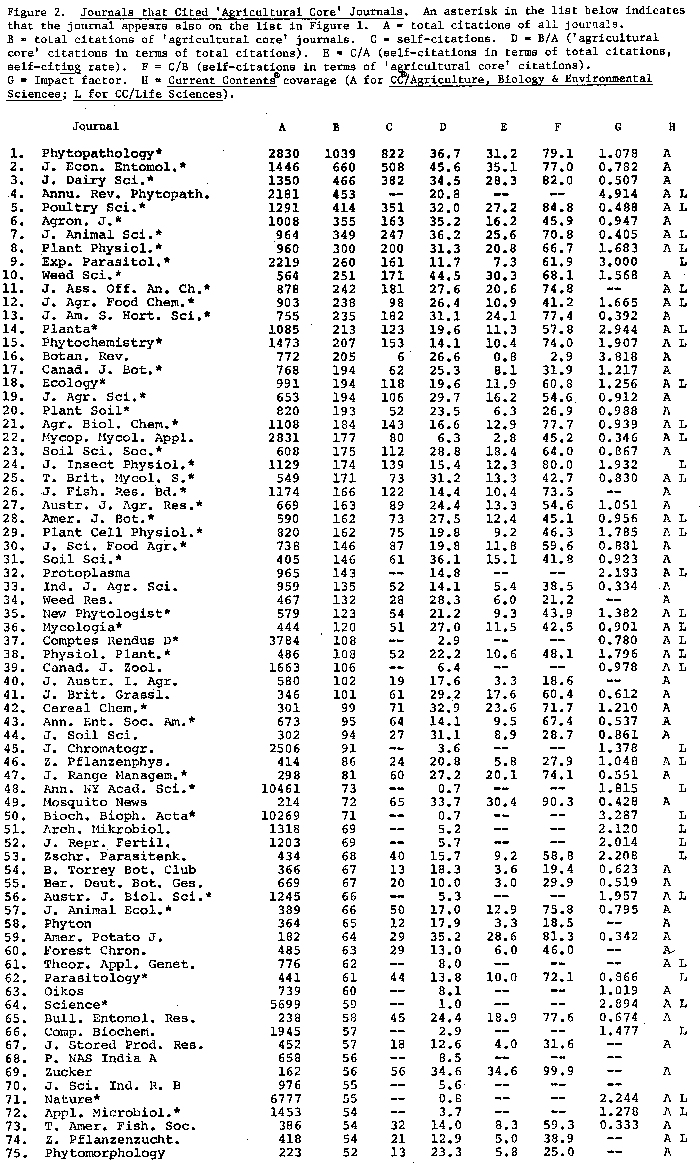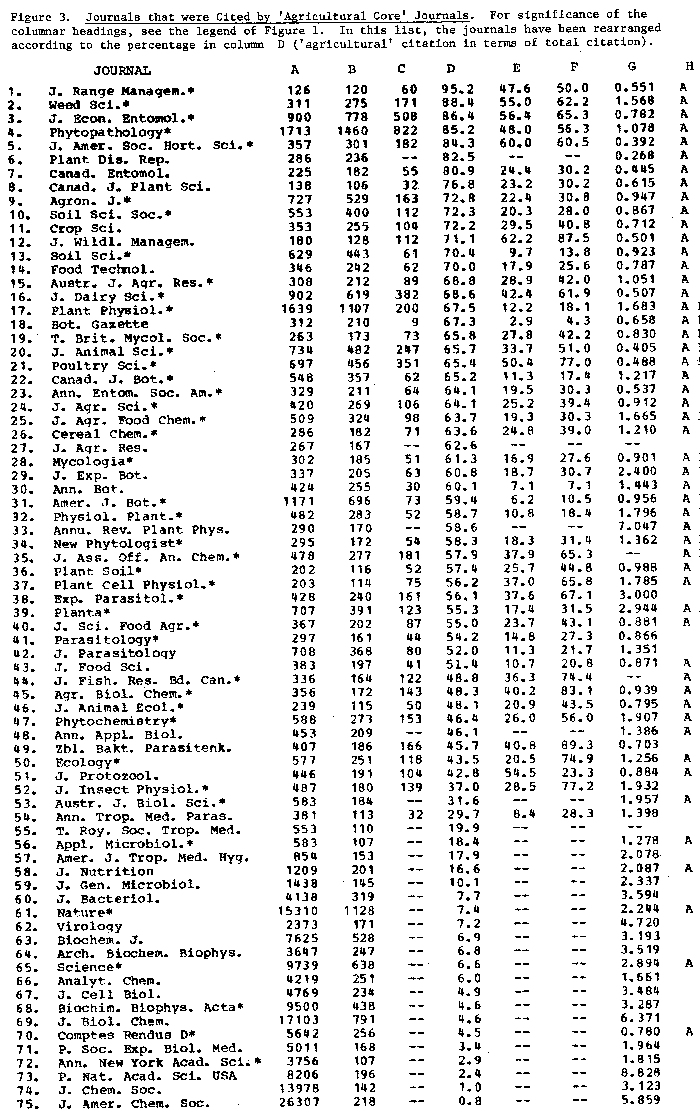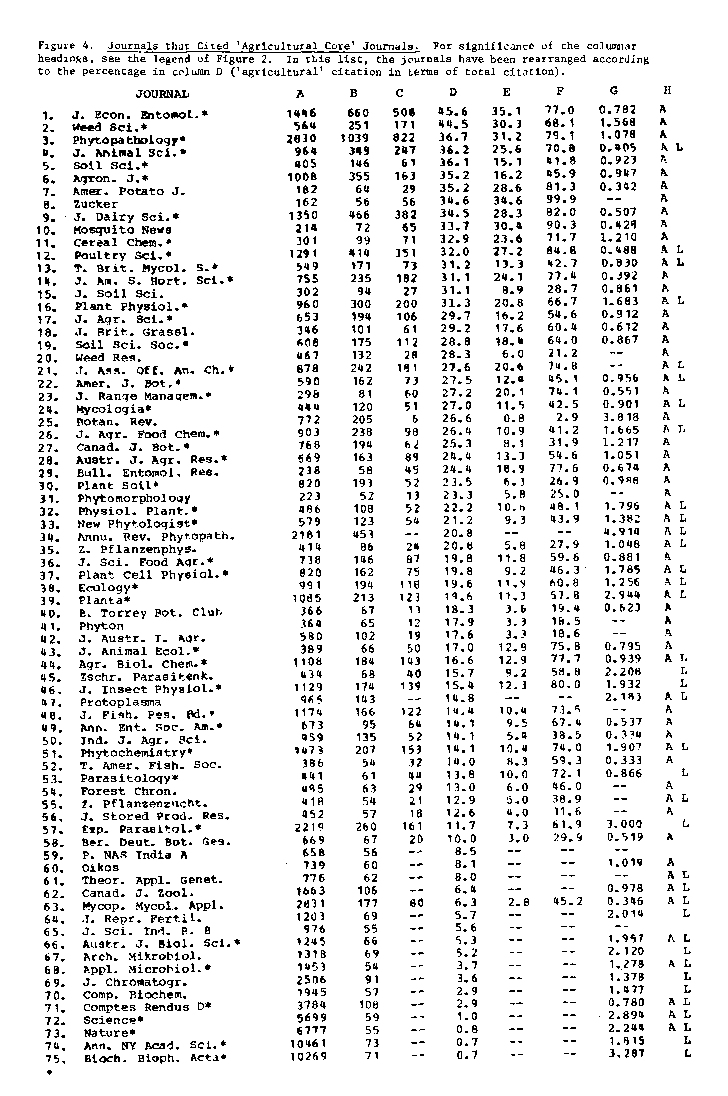In the past, I have frequently stressed the distinction between the literature of a specialty and the literature of interest to research workers in the specialty. This paper reports a citation analysis of agricultural journals. It may be the most telling example of the distinction I have tried to stress with the labels literature of agriculture, and literature of interest agricultural scientists.
As a starting point in the citation analysis, we arbitrarily defined as an ‘agricultural journal core’ journals in "obvious" agricultural categories in the ‘journal lists of the Science Citation Index (SCI)(1). The categories include agriculture, food technology, botany, entomology, ecology, fisheries, forestry, horticulture, parasitology, soil science, etc. Also arbitrarily, we added a few journals that we thought appropriate, for example, Pesticides Biochemistry and Journal of the Association of Official Chemists(formerly Journal of the Association of Official Agricultural) . We deliberately omitted from the study genetics and microbiology journals. In addition, we did not want the obvious dependence of genetics on basic research to skew the results that intuition suggested should be expected in analyzing citation patterns of more 'applied' agriculture journals. Nor did we include major multidisciplinary journals, in which we know agricultural scientists publish as frequently as they can. We fully expected, on the basis of previous studies of this type, that these journals would account for themselves.
This "core journal" base comprised 347 journals. As in some previously reported studies, (2-3) we treated then as a unit to discover what journals they as a unit cite, and what journals cite then as a unit. The database used in the analysis was composed of citation data from the last quarter 1969 SCI. The methodology has been explained in detail elsewhere. (4)
The results of our analysis are shown in Figures 1 and 2. The figures give only the top 75 journals in each case, but these are, however, quite sufficient for the purpose of this report.
Figure 1 shows the 75 journals most frequently cited by our agricultural core. Actually the core cited some 1650 items, plus innumerable theses, hut most of the 1650 items were journals. The core journals referenced the 1650 items with a total of 39,956 citations. The 75 journals on the list in Figure 1 account for 56.8% of those nearly 40,000 citations. The top 50 on the list account for 48%. This concentration exceeds that previously reported for science as a whole, where 50 journals account for about 33% of all citations, and 75 journals for about 40%. (4)

Figure 2 shows the 75 journals that cited (made reference to) our agricultural core most frequently. Actually, the core journals were cited by some 395 journals, as compared to the 1650 items that they cited. Tile core referenced these 395 journals with 13,031 citations. Again, the top 75 journals on the list account for most of them (88.3%). The first 50 account for 77%.

Before touching on details of the lists, I think we can say something important about the ‘agricultural literature’, though it may be obvious by now. The agricultural core journals cite other journals much more widely than they are cited by other journals. That fact, in my opinion, overrides anything else that may be said about what constitutes the ‘agricultural literature.’ It poses the question that is at the base of the distinction I have previously mentioned: what is the literature that agricultural scientists use? From these results, it is apparent that it is definitely .not congruent with the ‘literature’ that agricultural scientists produce. One must wonder, then, just what is meant by an 'agricultural library’, or an ‘agricultural information service’. An examination of tile lists in Figures 1 and 2 makes it plain, I think, that neither can be satisfied by describing them as consisting mainly of 'agricultural journals’.
Figure 1 shows us that among the journals ranked in order of importance to agriculture (whether or not one can call them ‘agricultural journals’) are -- with their ranks on the list-- Nature (2), Journal of Biological Chemistry (4) Science (7), Biochemical Journal (10) , Biochimica Biophysica Acta (14), Journal of Bacteriology (20), Comptes Rendus etc. (27) , Analytical Chemistry (30), Ecology (31), Archives of Biochemistry and Biophysics (32), Journal of Cell Biology (36), Journal of the American Chemical Society (37), and so on. Undoubtedly there are journals on the list that are ‘agricultural’ by anyone’s definition, but there are many more that very few people would characterize as ‘agricultural’. The list tells us, however, that they make up the literature of interest to agricultural research, tile literature agricultural scientists use. They are accordingly the journals that an ‘agricultural library’ and an ‘agricultural information service’ will need.
I regret that I can’t make tire complete list of cited items available for your inspection now. It would dispel tire illusion that ‘selectivity’ after a point will take care of this obvious dispersion of material important to agriculture. The full list shows that that is definitely not the case, before the illusory 'agricultural library’ can ‘select’ the American Potato Journal, for example, it must pick up Protoplasma, which the core cited more frequently. Before it ‘selects’ the Berichte der Deutschen Botanischen Gesellschaft it must pick up American Journal of Physiology. Before it ‘selects’ Journal of the American Society of Agronomists, it must pick up Journal of Laboratory and Clinical Medicine, Biochemistry, and Naturwissenschaften. Before it ‘selects’ Flora, Hilgardia, Acta Botanica Neerlandica, it must pick up Journal of Immunology, Journal of Molecular Biology, American Journal of Epidemiology, Zeitschrift fuer Naturforschung. Before it ‘selects’ Journal of Horticural Science it must pick up Lancet and Journal of Cell Science, and Journal of General Physiology. In all these cases, if tile illusory library ‘selects’ the obvious ‘agricultural’ journal, it will have selected journals that citations —that is, that agricultural research— has shown are of lesser importance in agricultural research than the non-agricultural journals I have named.
At this point, I can make a statement that, earlier in this presentation, might have seemed so obvious as to he meaningless. An agricultural library, or an agricultural information service, ought to be a science library or a science information service. It is the researchers, not we librarians and information workers who determine this. When their interests change, citation analysis can help us keep abreast of those changes. (5)
In Figure 2 are tire agricultural journals that post heavily cited tile agricultural core. For tile most part, there will be little argument about their being ‘agricultural’ journals, but --I must repeat-- they are not the journals that agricultural researchers use most. They are, rather, the written product of agricultural research. Even among these top 75, however, it is interesting to see that Science and Nature are better qualified as ‘agricultural journals’ than Phytomorphology, the last on the list, and more qualified than the 320 other journals on the complete list of 395 that most heavily cited the agriculture core.
There are 43 journals common to the two lists of 75, but their rankings on the two lists differ considerably. The shared journals are indicated by an asterisk after the journal title abbreviation.
I should like to take this opportunity to say something about the coverage of Current Contents/Life Sciences (CC/LS) and Current Contents/Agriculture, Biology & Environmental Sciences (CC/AB&ES). In the figures, CC coverage is indicated by an A and/or L in the last column (for CC/AB&ES and CC/LS respectively). It’s frequently suggested that a researcher should not have to subscribe to more than one edition of CC. Agricultural researchers frequently say they would prefer to have all of what they need in CC/LS or in CC/AB&ES. I wish that were possible, just as I wish it were possible in time case of clinical researchers who say the same thing in relation to CC/LS and CC/Clinical Practice, or in time case of certain chemists who say tire same thing in relation to CC/LS and CC/Physical & Chemical Sciences. Although we have tried, and I think to a good extent succeeded, in making CC/LS serve time interests of as many different ‘specialists’ as possible, it’s coverage cannot be skewed to emphasize some specialties’ interests at the expense of others. Coverage of tire various editions of CC is a difficult problem, and in many instances 110 doubt intuition plays a role in journal selection. Citation analysis, however, as I’ve indicated elsewhere, (6) has been of great help in supplying objective criteria. The positive results can be demonstrated with these two short lists of 75 journals.
Of the 75 journals on the list in Figure 1, 26 are covered by both CC/LS and CC/AB&ES; 26 are covered by CC/AB&ES alone; 22 are covered by CC/LS alone, and one (Journal of Agricultural Research is no longer published.
If the journals in Figure 1 are rearranged in order of the percentage of 'agricultural citations’ in terms of total citations, you will find that there is first a group covered exclusively by CC/AB&ES, then a group covered mainly by both CC/LS and CC/AB&ES, and finally a group covered exclusively by CC/LS. That is exactly as it should be, in my opinion. If the journals in Figure 2 are rearranged in the same manner, however there is no such abrupt demarcation. The doubly covered journals merely tend to be distributed throughout tile second two-thirds of the rearranged list.
We are frequently asked why we at ISI do not produce ‘specialty’ citation indexes, of greater or lesser scope—a 'biochemical' citation index, or a ‘life sciences’ citation index, tie could do so, but I have no doubt at all that users would soon find them unsatisfactory. Users of these hypothetical ‘specialty’ citation indexes would soon find they need broader coverage. The ‘biochemical’ citation index would have to be enlarged, and would turn out to be tire ‘life sciences’ citation index. In time, that ‘life sciences’ citation index would have again to be enlarged, and we would end with what we have now--the Science Citation Index. The SCI reflects both tire multidisciplinary character of research in the natural sciences, and it provides time multidisciplinary access to tire literature of research, no matter what time specialty starting point of the researcher. Thus, we could produce an Agricultural Citation Index, or at least produce a series of volumes that would carry such a title. But if we were to restrict it to so-called agricultural journals, users would quickly demand an enlargement of coverage. That enlargement would result in the same Life Sciences Citation Index in turn demanded by biochemists. Arid tire hypothetical Life Sciences Citation Index would in turn inevitably become the Science Citation Index that is already available. Those facts are beyond dispute. They were among the earliest of our discoveries in my first studies of the potential of citation indexing for science. I tried to produce a Genetics Citation Index. Indeed, I still have a volume with such a title, but the attempt was a failure in that it fell short of the intended goal. In a real sense, the Science Citation Index exists because it was impossible, with anything but a Science Citation Index to fill time need for a Genetics Citation Index. The same, I believe, is true in tile case of a hypothetical Agricultural Citation Index. The only satisfactory Agricultural Citation Index is a Science Citation Index. Fortunately, the Science Citation Index exists.
In short, agricultural scientists use and cite the same hard core of frequently cited basic research journals used by all other research workers in the life sciences. Their purpose, the slant of their interest, their mission, if you will, may differ, but the materials are the same. Indeed the appellation agriculture describes only tile mission, rather than any approach to time problem with which agricultural scientists deal. Thus, an agricultural research library is by definition --as our study, I believe, has shown-- a basic science research library.

